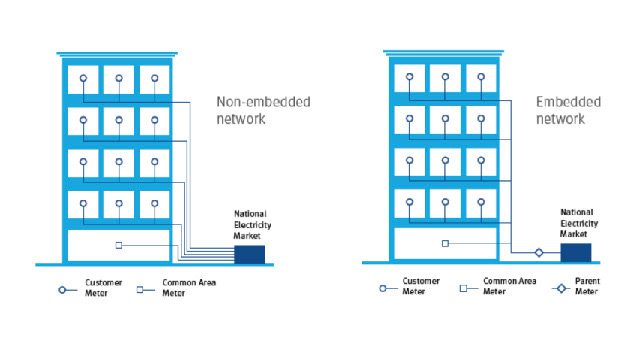The majority of strata-titled properties in Western Australia are set up to monitor and measure electricity using a multi-master network. This is where a strata or survey-strata scheme has lots that are individually metered for their electricity. Lot owners in a multi-master network purchase electricity directly from a retail supplier, typically resulting in higher retail electricity supply rates.
What are Embedded Networks?
Embedded networks create a privately-owned electricity network that supplies all lots within a strata complex. This system allows the Strata Company to contract with an energy retailer, negotiate better prices, and alleviate the costs and complications of individual systems.

Image sourced from: https://ap2u.com.au/embedded-networks-explained/
Key Advantages of Embedded Networks
- Cost Efficiency
- The strata community can negotiate cheaper electricity prices compared to individual lot owners by dealing with energy supply on behalf of multiple owners. For more details, check out the Australian Energy Regulator’s page on embedded networks.
- Power purchased at a discount by the strata company can provide an additional revenue stream by charging residents rates similar to what Synergy charges. The difference between the bulk purchase cost and resident charges can be used to reduce owner levies or fund additional strata expenses.
- Integration of Modern Technologies
- The space between the parent meter and sub-meters is ideal for setting up solar panels, battery storage, and electric vehicle charging stations, avoiding the complexities of individual systems.
- Embedded networks allow for the seamless integration of future technological advancements, keeping the strata community at the forefront of modern living amenities.
- Alternative Energy Retailers
- A single master meter connection to the grid allows the strata community access to alternative energy retailers, beyond just Synergy, providing more options and competitive pricing. Explore options through the Energy Made Easy.
Considerations and Challenges
While embedded networks offer numerous benefits, there are important considerations and potential challenges:
- Initial Costs and Levies
- Establishing an embedded network may initially increase levies and strata-related costs. However, the long-term benefits often outweigh the initial investment.
- Complex Contracts:
- Entering complex contracts with energy providers can lead to restrictions that owners may later regret. It’s crucial to carefully choose an embedded network manager and work closely with the Strata Manager to mitigate risks. For more on managing these risks, visit Consumer Protection WA.
- Transitioning to a Master Meter
- For strata plans designed with independent meters, transitioning to a master meter system requires careful consideration and owner consensus. This includes decisions on shared roof space for solar facilities and participation in energy trading plans to reduce electricity costs. More information on transitioning can be found at the Clean Energy Council.
Why Should I Consider Embedded Networks?
While the cheaper power supply is a clear advantage for those occupying the premises, there are also advantages that benefit the strata company as a whole, even if the majority of residents are tenants.
Initially, it may appear that establishing this system contributes to increased levies and strata-related costs. However, the power generated and purchased at a discount by the strata company will provide an additional revenue stream. This is achieved by continuing to charge residents up to the rates that Synergy charged. The strata company can then use the difference between the cost of the bulk power and the charge to the resident as additional income to either reduce owner levies or fund additional strata expenses, depending on the needs of the complex.
While this seems to be a relatively risk-free approach to sustainable practices, it is not without its complications. Lack of understanding entering embedded networks can be one of the biggest shortfalls as owners enter complex contracts with energy providers, leading to situations where owners regret the restrictions they have locked themselves into. This highlights the importance of carefully choosing an embedded network manager and working in partnership with the Strata Manager to reduce these risks. Having strata managers who have taken the time to investigate this and provide independent guidance and a long-term vested interest in the strata company’s success will provide the greatest opportunities for successful integration.
To maximize energy-saving benefits in a strata community, one of the first steps is to ensure the property is running off one main master meter. This is simple when the strata plan was designed this way, but there are plans that have been designed with each lot having an independent meter with Synergy and not recognized as a community in common. These strata companies require careful consideration from the owners to decide if they wish to manage their power with a system that allows the property to maximize efficiency. These considerations may include the need to share roof space for solar facilities or signing up for an energy trading plan to reduce the cost of electricity supply. It can be well worth the time spent considering these options and converting a complex to a master meter and establishing an embedded network.
For more detailed information, visit our Strata Title for Beginners page and explore our resources. To understand embedded networks further, check out this article and the Australian Energy Regulator’s guide.









